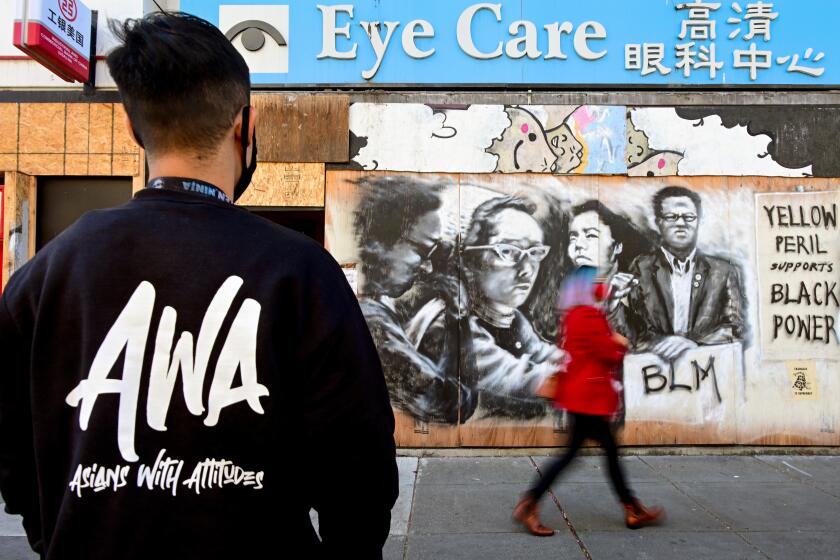She couldn’t eradicate anti-Asian hate crimes. So she made a handbook on how to fight them

- Share via
The COVID-19 pandemic had already left Anna Yao’s grandparents largely confined to their Oakland homes.
In March, after a series of violent attacks against elderly Asian Americans in the Bay Area, all four became afraid to venture out even for groceries or haircuts.
Yao’s maternal grandmother, Ellen Liu, said her legs wouldn’t be able to “carry her far enough” if she were attacked.
Yao’s paternal grandmother, Li Wang, confided that she wouldn’t know what to do if “someone didn’t like them just walking around — and what if it pushed strangers to do something violent?”
At Magnolia Mini Mart, a combination coffee shop and market, Yao picked up a bundle of pocket-sized booklets titled “How to Report a Hate Crime,” in both English and Chinese, for her grandparents, other family members and friends.
“What matters more than safety?” the 26-year-old tutor said. “When you feel helpless, you need to think hard about what else you can do.”
The booklets were created by Esther Lim, a 32-year-old operations director for a surfwear company who lives in Highland Park.
In addition to traditional and simplified Chinese, the volumes come in Japanese, Korean, Spanish, Tagalog, Thai and Vietnamese, with locally specific versions for Los Angeles and Orange counties, the Bay Area and New York.
As anti-Asian violence rose during the pandemic, spurred in part by the mistaken belief that Asians brought the coronavirus from China, Lim felt “a deepening sense of heartbreak.” She feared that racists would target her mom and dad, who are in their 60s.
About 68% of the anti-Asian attacks documented during the pandemic were verbal harassment, 21% were shunning and 11% were physical assaults.
Although she couldn’t eradicate racism, she could arm the victims of hate crimes with information.
She spent $4,000 of her own money to write and publish an initial run of booklets in English and Chinese, later shelling out more than $6,000 for legal advice and to launch a website.
“I had to find a way to protect victims who may not know what resources they can tap into,” said Lim, who is Korean American.
She contacted the Los Angeles Police Department’s hate crime coordinator, Det. Orlando Martinez, drawing on his expertise to refine the advice in the booklet, including the logistics of how to report a hate crime.
She added versions in Japanese and Korean. Word spread. Residents lauded her activism, donating to her GoFundMe campaign, which sparked contributions from high school classmates and church groups as well as from supporters as far away as Europe and Canada.
Parents and grandparents reviewed the handbook with their American-born children and grandchildren, poring over tips such as carrying a whistle and avoiding going out alone.
Members of the Rosemead Chamber of Commerce paid to have 1,000 booklets printed and distributed in Chinese and Vietnamese around the San Gabriel Valley. Grassroots groups also came to Lim’s assistance, using their connections to circulate the volumes within the Bay Area’s ethnic enclaves, with volunteers from the San Francisco Korean Center Inc. and a group of Asian firefighters from the San Francisco Fire Department stepping up to help.
Even before the Atlanta-area spa attacks that killed eight people, including six women of Asian descent, volunteer groups have sprung up to defend their Asian American communities in California.
The handbook urges users to memorize English phrases such as, “Someone is following me. Can you stay next to me until it’s safe?”
It lays out the elements of a hate crime, which threatens a person or property, versus a hate incident, which is a racist verbal or written attack. It describes how to document an attack and lists phone numbers for reporting a crime in each region.
With an additional $26,000 in donations, she expanded the languages to Thai and Vietnamese and made a version for Northern California.
“I don’t want people to feel trauma or fear reaching out to society when there are so many others supporting our mission to be treated with respect,” Lim said.
In Los Angeles, a staff member from the city’s L.A. vs. Hate campaign — which leverages social media to push residents to understand the importance of reporting hate crimes — introduced Lim to an insurance sponsor to help fund more booklets.
A board member of the Thai Town Council paid for the printing of 3,000 copies in Thai, which were distributed in early April across Los Angeles.
The increasing support couldn’t be timelier, supporters say.
Asian Americans are the least likely of all races to admit they are “very comfortable” reporting hate crimes to officials, according to a new survey from AAPI Data.
“This is exactly why we need awareness — why we need activism,” said Karthick Ramakrishnan, professor of public policy at UC Riverside. “You can have public seminars or private training sessions, but until people step up to spark action, to take ownership of the issue and figure out how to help their fellow Asians, especially the elderly, the quiet habits will continue.”
Respondents to the survey said being of being attacked again — or the idea of bringing unwanted attention to themselves or their families — prevent them from reporting crimes, he said, adding: “It may sound strange that someone has to literally write a guide, but if you don’t have creative solutions, what you produce is a sense of fear and hopelessness.”
Yao believes the booklets have given her grandparents a “significant” amount of comfort.
“We did go over the material,” she said, “checking to see if they have any questions, any more confusion.”
Her maternal grandparents recently stepped out to buy birthday cake.
They carried whistles in case they were attacked — and they knew whom to call if that happened.
More to Read
Sign up for Essential California
The most important California stories and recommendations in your inbox every morning.
You may occasionally receive promotional content from the Los Angeles Times.
















